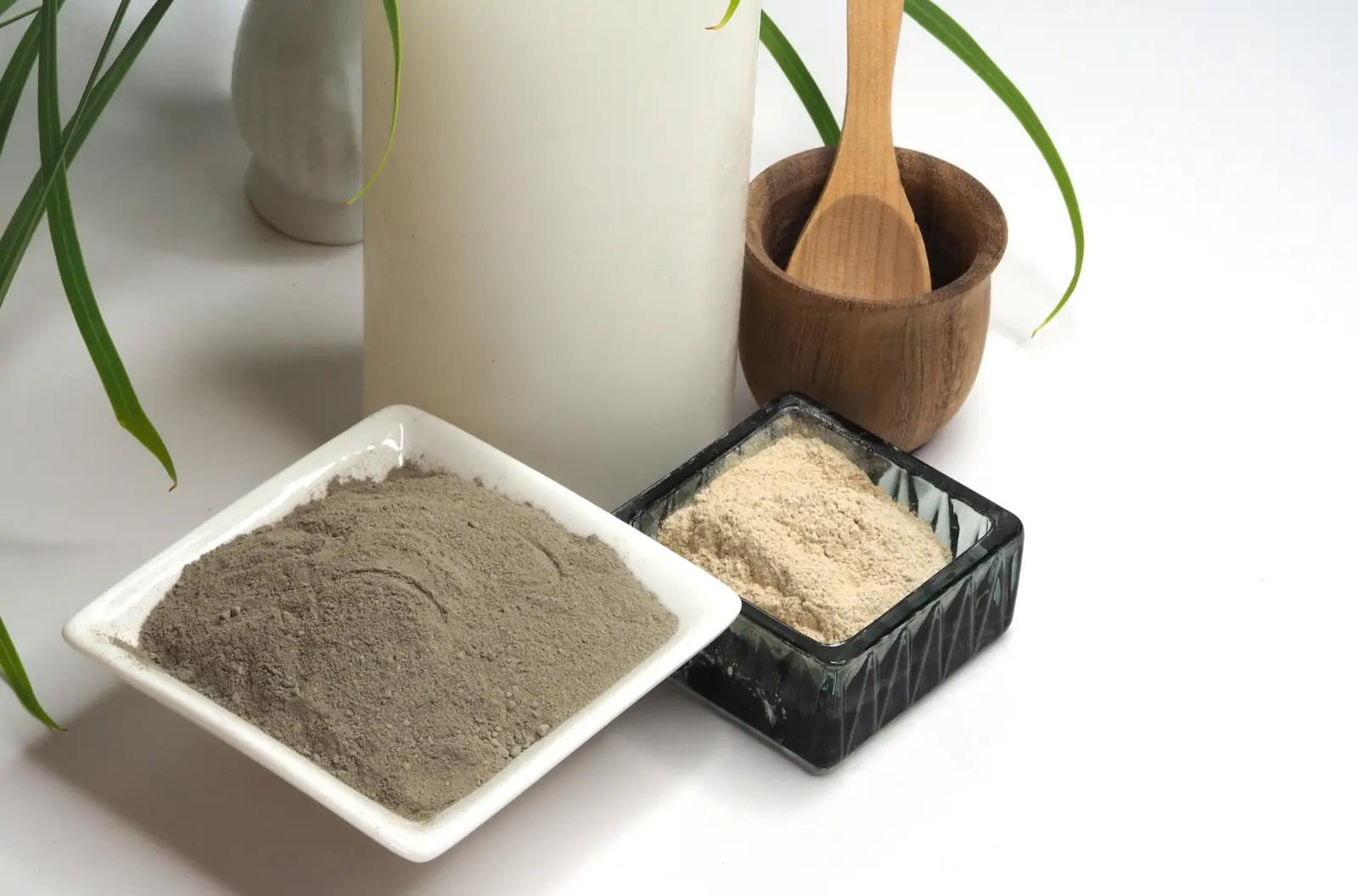1 tablespoon of Bentonite clay powder 2-3 tablespoons of water or apple cider vinegar (for a more potent mask) A non-metallic bowl and spoon (Bentonite clay reacts with metal, reducing its effectiveness) Add the Bentonite clay powder to the bowl. Gradually add water or apple cider vinegar while stirring until a smooth, paste-like consistency is achieved. Ensure there are no lumps in the mixture for even application. Apply the mask evenly to your face, avoiding the sensitive eye and lip areas. Allow the mask to sit for 10-15 minutes. For sensitive skin, start with 5-10 minutes to avoid over-drying. Rinse the mask off with warm water once it starts to dry and tighten on your skin. Gently pat your face dry with a clean towel and apply a moisturizer to keep your skin hydrated. Oily Skin: Bentonite clay helps absorb excess oil, leaving the skin matte and less prone to breakouts.
Acne-Prone Skin: Its detoxifying properties can help reduce acne by unclogging pores and calming inflammation.
Combination Skin: It balances oily and dry areas, making it suitable for use on the T-zone while hydrating other areas.
Bentonite clay is also effective as a spot treatment for acne or irritated skin.
Mix a small amount of Bentonite clay with water or apple cider vinegar to form a thick paste. Ensure the mixture is thick enough to adhere to the skin without dripping. Apply a small amount directly to the blemish or irritated area. Leave it on for 15-20 minutes or overnight for a more intensive treatment. Gently rinse off the clay with warm water once it has dried. Pat the area dry and apply a non-comedogenic moisturizer to prevent dryness. Always do a patch test before using Bentonite clay on your face, especially if you have sensitive skin. Avoid using metal utensils when mixing the clay, as it can reduce its effectiveness. If you experience excessive dryness or irritation, reduce the frequency of use or mix the clay with a hydrating ingredient like honey or aloe vera. Ensure you are using food-grade Bentonite clay. Not all Bentonite clays are suitable for internal use, so it’s crucial to choose a high-quality, food-grade product. Mix 1/2 to 1 teaspoon of Bentonite clay with 8 ounces (about 240 ml) of water. Stir the mixture well using a non-metallic spoon to avoid any reaction with the clay. Let the mixture sit for 5-10 minutes, allowing the clay to fully absorb the water and expand. Start with a small amount, such as 1/2 teaspoon, and gradually increase to 1 teaspoon as your body adjusts. Drink the mixture on an empty stomach, preferably in the morning or before bedtime. Follow with an additional 8 ounces of water to help flush out the toxins. Toxin Removal: Bentonite clay binds to toxins in the digestive tract, helping to remove them from the body. Digestive Health: It may aid in improving digestion by reducing bloating and gas. Alkalizing Effect: Bentonite clay can help balance the body’s pH by providing essential minerals. Always consult with a healthcare provider before starting any detox regimen, especially if you have any pre-existing medical conditions. Avoid using Bentonite clay internally if you are pregnant or breastfeeding. Drink plenty of water throughout the day to prevent constipation, as Bentonite clay can be dehydrating. Bentonite clay can also be used externally in detox baths, providing a natural way to cleanse the skin and body of impurities.
Fill your bathtub with warm water, making sure the temperature is comfortable for soaking. Measure out 1/2 to 1 cup of Bentonite clay powder, depending on the size of your tub. Gradually add the Bentonite clay to the bathwater, sprinkling it evenly across the surface. Use your hands or a non-metallic spoon to stir the water, ensuring the clay is fully dissolved and evenly distributed. Soak in the bath for 20-30 minutes, allowing the Bentonite clay to draw out toxins through your skin. Relax and enjoy the soothing effects of the clay as it cleanses and revitalizes your skin. Rinse off in the shower after your bath to remove any clay residue from your skin. Gently pat your skin dry with a towel and apply a moisturizing lotion to prevent dryness. Toxin Removal: The clay absorbs toxins through the skin, aiding in overall detoxification.
Skin Purification: Bentonite clay helps unclog pores, reduce inflammation, and improve skin texture.
Relaxation: The minerals in Bentonite clay can have a calming effect, reducing stress and promoting relaxation.
Limit detox baths to once or twice a week to avoid over-drying your skin. If you have sensitive skin, consider using less clay or shortening the soak time. Bentonite clay is an excellent natural ingredient for hair care, particularly in creating hair masks that promote scalp health and strengthen hair. Here’s how to create and apply a Bentonite clay hair mask:
2-3 tablespoons of Bentonite clay powder 1/2 cup of water or apple cider vinegar (ACV) Optional: 1-2 tablespoons of aloe vera gel or a few drops of essential oils (e.g., lavender or rosemary) for added moisture and fragrance A non-metallic bowl and spoon In a non-metallic bowl, combine the Bentonite clay with water or ACV. The apple cider vinegar provides a more acidic base, which can help in balancing the scalp’s pH. Stir the mixture until it forms a smooth, thick paste. Adjust the amount of liquid to achieve the desired consistency—thick enough to stay on your hair without dripping. Section your hair into parts to ensure even application, especially if you have thick or long hair. Apply the mask generously from the roots to the tips of your hair, focusing on the scalp. Use your fingers or a wide-tooth comb to distribute the mask evenly. Once applied, cover your hair with a shower cap to prevent the mask from drying out too quickly. Allow the mask to sit on your hair for 20-30 minutes. During this time, the Bentonite clay works to detoxify the scalp, absorb excess oil, and strengthen the hair. Rinse the mask out with warm water. You may need to rinse a few times to ensure all the clay is removed from your hair. Follow up with a mild shampoo and conditioner to remove any remaining residue and to keep your hair soft and hydrated. Scalp Health: Bentonite clay detoxifies the scalp by drawing out impurities, which can help reduce dandruff and other scalp conditions.
Hair Strength: The minerals in Bentonite clay strengthen hair strands, making them less prone to breakage and promoting overall hair health.
Volume and Shine: Regular use of Bentonite clay hair masks can enhance the natural volume and shine of your hair, making it look healthier and more vibrant.
Bentonite clay is also effective for treating specific scalp issues, such as dandruff or irritation. Here’s how to use Bentonite clay for targeted scalp treatments:
Mix 1-2 tablespoons of Bentonite clay with water or ACV to create a smooth, thick paste. Optional: Add a few drops of tea tree oil or peppermint oil, known for their antifungal and soothing properties, to enhance the treatment. Part your hair into sections to expose the scalp. Apply the Bentonite clay mixture directly to the affected areas of the scalp, focusing on spots where dandruff or irritation is most prevalent. Massage the clay gently into the scalp using your fingertips to ensure it penetrates deeply. Let the clay sit on the scalp for 15-20 minutes. This allows the clay to absorb excess oil, reduce inflammation, and eliminate dandruff-causing fungi. Rinse the treatment out thoroughly with warm water, ensuring that no clay residue is left on the scalp. Follow with a gentle shampoo and conditioner to soothe and moisturize the scalp. Dandruff Control: Bentonite clay helps to reduce dandruff by absorbing excess oil and removing dead skin cells from the scalp.
Soothing Irritation: The clay’s anti-inflammatory properties can calm an irritated scalp, reducing redness and discomfort.
Overall Scalp Health: Regular treatments with Bentonite clay can improve the scalp’s overall health, leading to stronger hair growth and less frequent flare-ups of dandruff or irritation.
Bentonite clay has gained popularity as a natural ingredient for oral care due to its detoxifying and remineralizing properties. It can be used to make homemade toothpaste and mouthwash that promote oral hygiene and overall mouth health.
Using Bentonite clay as a base for toothpaste can help remove plaque, whiten teeth, and freshen breath without the use of harsh chemicals. Here’s how to make and use Bentonite clay toothpaste:
2 tablespoons of Bentonite clay powder 1 tablespoon of coconut oil (softened) 1 tablespoon of baking soda (optional, for additional whitening) 10-15 drops of peppermint or spearmint essential oil (for flavor) A few drops of filtered water (to adjust consistency) A non-metallic bowl and spoon In a non-metallic bowl, combine the Bentonite clay powder and baking soda (if using). Add the softened coconut oil and mix thoroughly until the ingredients form a thick paste. Add the essential oil drops and a few drops of water to achieve your desired consistency. The paste should be thick enough to stay on your toothbrush without being too dry. Transfer the toothpaste into a small glass jar with a lid. Store it in a cool, dry place to keep it fresh. Avoid using a metal container or spoon, as Bentonite clay can react with metal and lose its effectiveness. Scoop a small amount of toothpaste onto your toothbrush using a non-metallic utensil. Brush your teeth as you normally would, making sure to cover all surfaces of your teeth and gums. Rinse thoroughly with water after brushing to remove any residue. Plaque Removal: Bentonite clay binds to plaque and bacteria in the mouth, helping to remove them from your teeth and gums.
Remineralization: The clay’s mineral content can help remineralize tooth enamel, making your teeth stronger and less prone to decay.
Fresh Breath: Essential oils like peppermint add a refreshing flavor and can help eliminate bad breath naturally.
Bentonite clay can also be used to create a natural mouthwash that detoxifies the mouth and supports gum health. Here’s how to make and use Bentonite clay mouthwash:
1/2 teaspoon of Bentonite clay powder 10 drops of essential oil (e.g., peppermint, tea tree, or clove) A non-metallic container for mixing and storage In a non-metallic container, add the Bentonite clay powder to the filtered water. Stir well until the clay is fully dissolved, creating a cloudy mixture. Add the essential oil drops and stir again to combine. Store the mouthwash in a glass bottle or jar with a tight-fitting lid. Shake well before each use to re-distribute the clay. Pour a small amount of the mouthwash into your mouth and swish it around for 1-2 minutes. Spit out the mouthwash and rinse your mouth with clean water. Detoxification: Bentonite clay binds to toxins and bacteria in the mouth, helping to cleanse and detoxify the oral cavity.
Gum Health: Regular use of Bentonite clay mouthwash can soothe irritated gums and reduce inflammation, promoting overall gum health.
Natural Freshener: The addition of essential oils provides a natural, refreshing taste, helping to keep your breath fresh throughout the day.
Always use food-grade Bentonite clay for oral care. If you experience any sensitivity or irritation, discontinue use and consult with a dentist. While Bentonite clay offers numerous benefits for skin, hair, and oral health, it’s important to use it safely and correctly to avoid any adverse effects. Below are key safety guidelines and potential side effects to consider when using Bentonite clay.
Bentonite clay is highly reactive with metals, which can reduce its effectiveness. When preparing Bentonite clay mixtures, always use non-metallic utensils, such as plastic, wooden, or ceramic tools. This ensures that the clay retains its full detoxifying properties.
Not all Bentonite clay products are created equal. For internal use, it’s crucial to source food-grade Bentonite clay from a reputable supplier. High-quality clay is free from contaminants and has been tested for purity. For external use, ensure that the clay is natural and free from additives or fillers.
Before using Bentonite clay on your skin or hair, perform a patch test to check for any allergic reactions. Apply a small amount of the clay mixture to a small area of your skin and wait 24 hours to see if any redness, itching, or irritation occurs. If you notice any adverse reaction, discontinue use immediately.
When ingesting Bentonite clay, it’s important to adhere to recommended dosages. Overconsumption can lead to digestive issues, such as constipation. Start with small amounts, such as 1/2 teaspoon mixed with water, and gradually increase as your body adjusts. Always consult with a healthcare provider before beginning any new detox regimen.
Bentonite clay can have a dehydrating effect, especially when used internally. Make sure to drink plenty of water throughout the day to help your body flush out toxins and prevent constipation.
While Bentonite clay is often used to aid digestion, overuse or improper use can lead to digestive discomfort, including constipation. This is because the clay expands and absorbs water in the digestive tract, which can slow down bowel movements. To prevent this, always follow the recommended dosage and stay hydrated.
For some individuals, Bentonite clay may cause skin irritation, particularly if left on the skin for too long or if applied too frequently. Symptoms may include redness, dryness, or itching. To minimize the risk, limit the use of clay masks to once or twice a week and always follow up with a moisturizer.
Although Bentonite clay is known for its ability to absorb toxins, some lower-quality products may contain trace amounts of heavy metals, such as lead. This highlights the importance of sourcing your clay from reputable suppliers who test their products for safety and purity.
Bentonite clay may interfere with the absorption of certain medications, including prescription drugs and supplements. If you are taking any medications, consult with your healthcare provider before using Bentonite clay, especially if you plan to ingest it.
The safety of Bentonite clay use during pregnancy and breastfeeding has not been extensively studied. Therefore, it is generally recommended that pregnant and breastfeeding women avoid ingesting Bentonite clay. For external use, consult with a healthcare provider before applying Bentonite clay to the skin.
Bentonite clay is a remarkably versatile natural product with a wide range of benefits for skin care, hair care, oral health, and overall detoxification. Its ability to absorb toxins, cleanse impurities, and provide essential minerals makes it a valuable addition to your self-care routine.
Skin Care: Bentonite clay can be used in facial masks and spot treatments to detoxify the skin, reduce acne, and improve overall complexion.
Hair Care: As a hair mask or scalp treatment, Bentonite clay strengthens hair, soothes the scalp, and helps combat dandruff and irritation.
Oral Health: In toothpaste or mouthwash, Bentonite clay promotes oral hygiene by removing toxins, remineralizing teeth, and freshening breath.
Detoxification: Whether ingested or used in a bath, Bentonite clay supports the body’s natural detoxification processes, helping to cleanse the digestive system and the skin.
Bentonite clay offers a natural, safe, and effective way to enhance your health and beauty routines. Whether you’re looking to improve your skin’s appearance, strengthen your hair, maintain oral health, or detoxify your body, Bentonite clay can be adapted to meet your specific needs.
Experiment with the various methods of using Bentonite clay, and discover which ones work best for you. As with any natural remedy, it’s important to use it correctly and consistently to achieve the best results. Incorporate Bentonite clay into your regular self-care regimen and enjoy the numerous benefits it has to offer.





